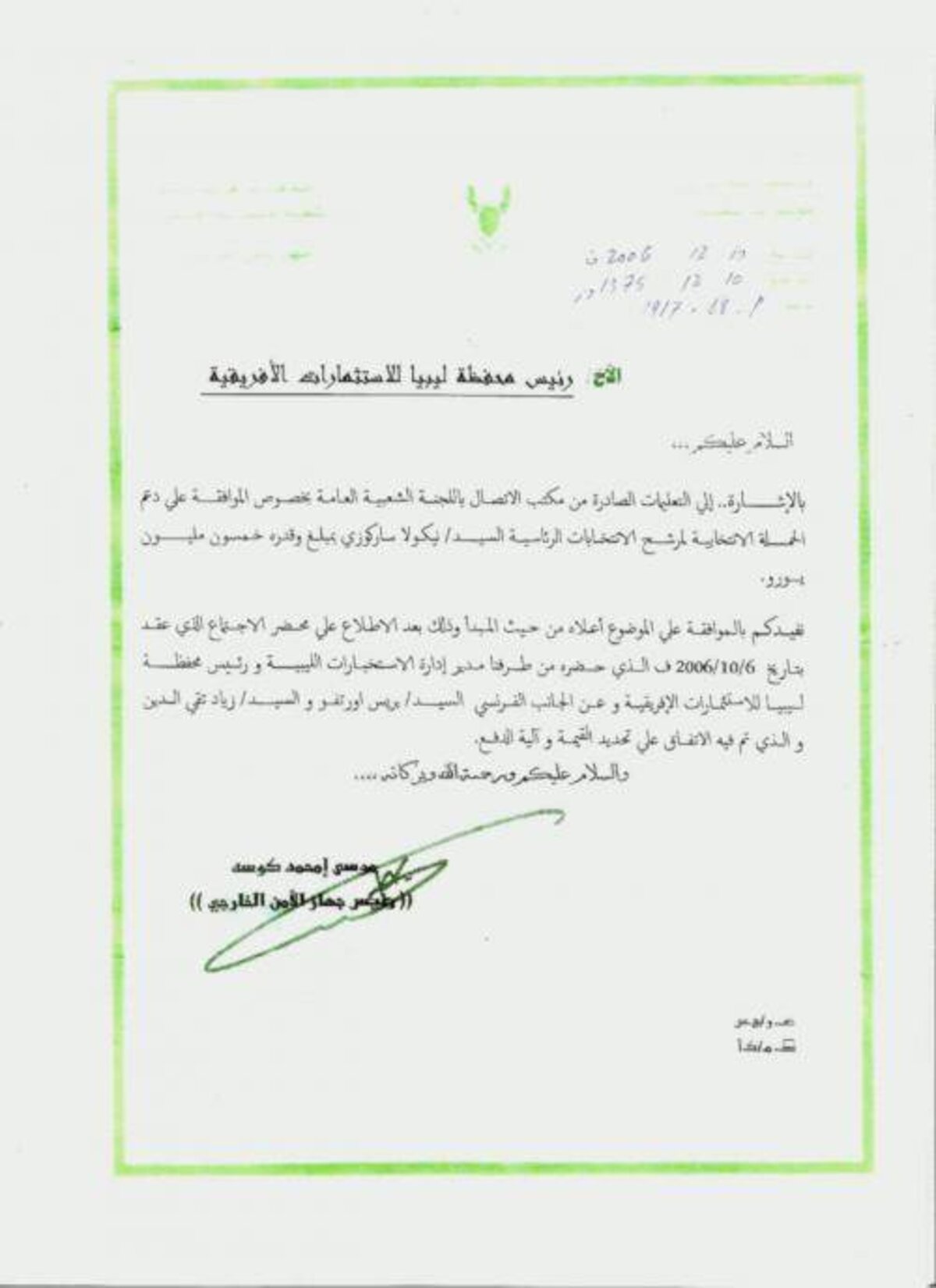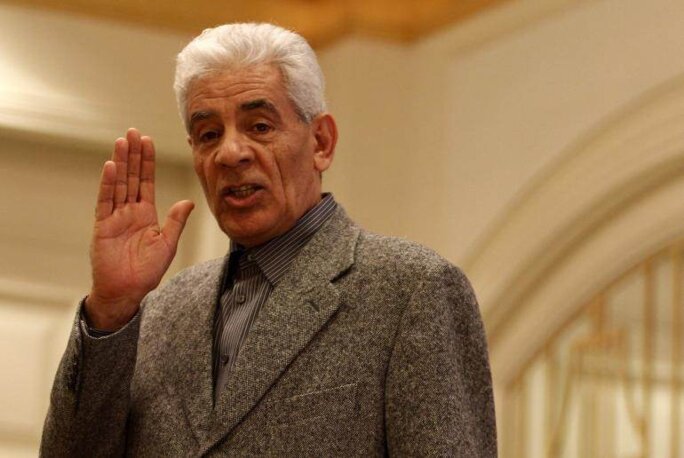In April 2012, Mediapart revealed an official Libyan document which detailed how the regime of late Libyan dictator Muammar Gaddafi had approved the payment of 50 million euros in secret funding of Nicolas Sarkozy's 2007 presidential election campaign.
The letter, dated December 10th 2006, is signed by Moussa Koussa, the then head of Libya's foreign intelligence agency, and is addressed to Gaddafi's chief-of-staff, Bashir Saleh, president of the Libyan African Portfolio (LAP), one of the main investment arms of the regime, and who was in charge of supervising the payments.
The publication of the document followed a lengthy series of investigations by Mediapart into the dealings with the Gaddafi regime by Sarkozy and his close entourage during the preparations for the latter’s bid for the French presidency.
The letter said that the regime had agreed to support “the electoral campaign of the candidate Monsieur Nicolas Sarkozy for the presidential elections, to the sum of fifty million euros”. The letter also stated that an agreement on “the amount and method of payment” had been reached at a meeting two months earlier involving Brice Hortefeux, a longstanding close personal and political ally of Sarkozy’s.

Enlargement : Illustration 1

After the publication of the document, Sarkozy lodged a complaint against Mediapart for ‘forgery and use of forgery’, which a subsequent police investigation found no grounds to pursue further. Sarkozy then lodged a lawsuit as a civil party against Mediapart, again for ‘forgery and use of forgery’ which, under French law, automatically triggered a judicial investigation to establish the authenticity of the document.
The Paris-based magistrates leading that investigation, René Cros and Emmanuelle Legrand, had already received testimony from numerous experts suggesting that the document is genuine, before the authentication by the graphologists this month of the signature of Moussa Koussa.
Meanwhile, a parallel judicial investigation was also opened to determine whether Sarkozy had received illegal funding from the Libyan dictator, who was overthrown and assassinated in 2011.
On August 5th this year, the magistrates in charge of that probe, Serge Tournaire and René Grouman, questioned Moussa Koussa in Qatar, where he has been living in exile since the fall of the Gaddafi regime. Mediapart has had access to the official records of his testimony, when Koussa told the French magistrates that he did not sign the document. “The contents are not false, but the signature is false,” he said under questioning. “It is not me who signed.” Koussa said the document was drawn up by Baghdadi Ali al-Mahmudi, who in December 2006 was secretary general of Libya’s General People's Committee, equivalent to the post of prime minister.
When he was asked to recognise his signature as it appeared on official papers requesting a French residency permit that he obtained in June 2008, and another that appears on documents requesting its renewal in April 2011, he said that these also were not his signatures.
However, during the questioning at his residence in Doha, the French magistrates noted that Koussa appeared to repeatedly answer with the help of a prepared written document he read from. “Why do you have need of a document to reply to our questions?” they asked him. Koussa replied: “They are ideas, point by point. Memory points.”
In October, graphologists Jean-Louis Lebrave and Claude Toffart studied several examples of Moussa Koussa’s signature. This included as it appears on each of the 13 pages of the transcription of his testimony given to the French magistrates in Qatar in August, which he countersigned in approval of what was recorded. It also included his signature as recorded on documents concerning the two requests he made for a residency permit in France. The graphologists compared these different signatures with that which appears on the document published by Mediapart.
After their individual studies of the signatures and also their joint study of them, the graphologists concluded that Moussa Koussa’s signature at the bottom of the December 10th 2006 letter is genuine. They also concluded that the signatures in his name on the two French residency permit requests were also authentic.
After receiving copies of the signatures on October 15th, the graphologists initially examined them separately, before meeting together to confront their findings on October 23rd when, they say in their testimony, they found themselves in “perfect convergence” in their analyses.
The graphologists detailed the characteristics of Koussa’s signature as it appeared in the letter published by Mediapart, which they conclude was made with “a spontaneous and ample graphic gesture”, the execution of which was “rapid” and in which they observe “neither hesitation nor trembling”. In their comparison of the signature on the letter with the signatures given by Koussa approving the transcriptions of his interview by the French magistrates in Doha, the graphologists observed said that both a broad and detailed study of them showed such a sameness that the signatures on the letter and the transcriptions “are by the same hand”.
The graphologists also called on the services of a translator of Arabic, Sylvana Kattar Monseur, a recognised expert on different aspects of the language who, their report reads, “validated elements concerning writing in the Arabic alphabet”.
In Monseur’s report, she noted: “Regarding the three signatures and the signatures for comparison made by the hand of Monsieur Moussa Koussa that have been presented to me, I can attest that these respect the movement of Arabic writing which moves from the right to the left.”
All three experts conclude that the signature on the December 2006 letter published by Mediapart, and the two signatures on Koussa’s request for a residency permit, were made “by the hand” of Koussa himself.
During the questioning of Koussa by the French magistrates in August, he was asked to explain what he meant when he said the contents of the letter published by Mediaprt were not false. “Its origins, its contents, that’s what,” he answered. “The contents of this document, that’s what is dangerous. It’s for you to know if it’s true or false. I didn’t tell you whether it was false or not. There is what is mentioned in this document and someone who has put a false signature underneath, for you to investigate.”

Enlargement : Illustration 2

Koussa claimed before the judges that the letter was drawn up by former Libyan prime minister Baghdadi Ali al-Mahmudi, now in detention in Libya after his deportation in 2012 from Tunisia, to where he fled after the Gaddafi regime’s collapse in 2011. Questioned about his claim, Koussa told the magistrates: “You ask me what elements I have to implicate him, it’s because we lived together, I mean by that that I knew him very well. You ask if I have elements to implicate him. Yes, I have, but don’t include me into this story.”
Mahmudi has himself told the Tunisian justice authorities that he coordinated the payment of a part of the funds approved for Sarkozy.
In an interview in 2013 with French television channel France 2’s flagship current affairs programme Complément d’enquête, Gaddafi’s former interpreter, Moftah Missouri, said the signature on the December 2006 letter was genuine.
Earlier this year the investigation received the testimony of Patrick Haimzadeh, a former French military officer who served as a councillor for military affairs at the French embassy in Tripoli between 2001 and 2004. He is also the author of a recognised book of reference about the Gaddafi regime, published in France under the title Au cœur de la Libye de Kadhafi (At the Heart of Gaddafi’s Libya’). He was questioned on March 25th by the French gendarmerie’s Paris criminal investigation unit (the section de recherches de Paris), appointed by the magistrates to question expert witnesses on the authenticity of the document. Mediapart gained access to his statement, included in the gendarmerie’s report on the experts’ findings.
Haimzadeh said he thought the Libyan move to make such a payment was plausible. “According to the practices of Gaddafi, which I described in my book, it was usual to provide financial support to other countries, entities, a president or opposition groups, notably African,” he said. “The strategic objective of G. [Gaddafi] was the rapprochement with Europe, and France in particular. I am therefore not surprised regarding the Libyan side, but I cannot comment on the reception of such support on the part of the French side.”
Regarding the presentation of the letter published by Mediapart, Haimzadeh said: “The green colour is that of the Libyan Jamahiriya as is also the logo and the typography used in the body of the text. It is the ‘kufic’ [Editor’s note: a calligraphic form of Arab script] both concerning the addressee and the title of the signatory.”
“The first date is that of the Gregorian calendar with the symbol ‘f’ corresponding to the sign used in Libya since 2000 to designate the Christian calendar,” Haimzadeh explained in his statement. “The second corresponds to the Libyan calendar used since 2000, a solar calendar that contains the same number of days as the Gregorian calendar. The numbers of the months and days are therefore the same, the only change being the number of the year because this calendar begins from the death of the prophet Muhammad, which is why the two letters follow the date 1374, which are abbreviations for ‘after the death of the prophet’. I confirm that the dates are coherent in both their correspondence and the evocation of the two calendars. All documents of this sort have only these two dates [...] Libyan documents for internal affairs were systematically presented with these two dates.”
“Then comes the register number which appears to me to be coherent,” Haimzadeh continued. “I note that at the bottom right of the paper appear symbols and initials that probably designate addressees from within the service.”
Another witness interviewed by the gendarmerie was Véronique Vouland-Aneini, who served as First Councillor of the French embassy in Tripoli between 2005 and 2008. In a statement given to the gendarmes, dated March 21st, she also assessed the authenticity of the document published by Mediapart. “The Arabic seems to me to be of a very good technical level, and corresponds with an administrative document of this nature,” she said. “Official Libyan documents did indeed include several dates […] In its general aspect, this could correspond with a Libyan document.”
Also questioned about the document was Jean-Guy Pérès, a former French police commissaire divisionnaire, (equivalent in Britain to a chief superintendent), who was internal security attaché at the French embassy in Tripoli, also between 2005 and 2008. “It entirely resembles official documents used by Libya regarding the text and the typography [...] The formulations are very similar to what I used to receive,” he told the gendarmes in a statement dated June 30th. “Even on as sensitive a subject, the fact that this document exists does not surprise me, the Libyans being very formal and bureaucratic. They put everything into writing.”
In February this year Mediapart published censored extracts from a book by Mohamed Al Magariaf, who was Libya’s first head of state after the fall of Muammar Gaddafi in 2011. Sections of his book Mon combat pour la liberté ('My fight for freedom') relating to the Gaddafi funding of Sarkozy were removed before publication by his publisher Cherche Midi, apparently from fear of potential legal action by Sarkozy. One of the censored extracts read: “It's not a question of blaming Nicolas Sarkozy, his commitment to the liberation of Libya was exemplary and the Libyan people are grateful for it. But why lie or deny? Yes, Gaddafi financed the Nicolas Sarkozy electoral campaign and continued to finance it still after 2007.”
-------------------------
The French version of this article can be found here.
English version by Graham Tearse


